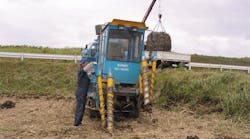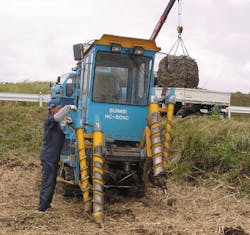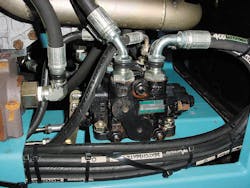Among the agricultural equipment manufactured by Bunmei Mfg., Kagoshima, Japan, the HC-50 sugar cane harvester presents a real challenge for routing hydraulic lines between pumps, valves, filters, and actuators. These actuators include a pair of hydraulic motors for the track drive, four hydraulic motors that drive two pairs of augers, conveyor drive motors, plus auxiliary functions. As the harvester advances through a field, the spinning augers pull the stalks of cane upright so they can be cut cleanly at their base. The entire hydraulic system is driven by a 57-kW (76-hp) engine, and everything must fit within the tight confines of this compact machine.
Hoses, hoses, and more hoses
The HC-50 performs at least a dozen hydraulic functions, all of which are plumbed with hydraulic hose. In many cases, rigid tubing assemblies could have been specified, but because so many lines must be routed in such a small area, installation would be nearly impossible without the flexibility of hose. Furthermore, because each metal tube would require a complex series of bends, cost to manufacture each tube assembly would have been too great.
As might be expected, installers must follow specific instructions that define the exact sequence of hose placement. Not following these instructions precisely could cause the installer to paint himself into a corner, so to speak. Correcting the mistake of installing a hose before its turn could necessitate having to remove several hoses until reaching the step when the errant hose should have been installed — a real drain on productivity.
Problems down the road
Even if hose installation goes smoothly, other potential problems may crop up in the future For example, if hoses are installed so that they rub together as the machine operates, abrasion could wear away the hose cover, leading to serious leakage. Furthermore, in trying to get hoses to fit into the cramped quarters, installers may end up bending a hose beyond its minimum recommended radius. Doing this would reduce the hose's service life and pressure capacity. Worse yet, it could cause the hose to pull away from the coupling, again resulting in serious leakage.
The tight quarters also make it difficult to follow preferred hose installation practices. Scott Campbell, product manager at Eaton Corp.'s Aeroquip Tech Center, Maumee, Ohio, explains. "Ideally, hose should be installed so that it bends in only one plane. As long as you don't exceed the minimum bend radius, it's okay to bend a hose to the left, then to the right. But that same assembly should not also be bent away from you or toward you."
"Also, the hose should never be twisted," continues Campbell. "That's what the lay line is for — it serves as a visual guide to ensure that the installed hose is not twisted. If it is, the hose will not achieve its expected life or pressure rating. Ultimately, the hose will fail or work loose from the end fitting."
Finally, every time a hose is connected to a component port or fitting, the potential for leakage exists if mating connectors are not properly tightened. Obviously, then, technicians responsible for installing the hydraulic hose on these machines must pay close attention to assembly procedures.
Simplifying the situation
Recognizing the high potential for problems, and wanting to make installation less labor intensive, officials at Bunmei wanted a simpler and faster way to install hoses. The solution they adopted was to incorporate Eaton's Aeroquip STC (snap-to-connect) couplings for all hose ends. As their name implies, STC connectors are installed simply by pushing the make fitting into female adapter. Removal is performed by placing a wrench into a slot in the connection and separating the two halves.
Campbell explains, "Better hose routing improved installation and simplified maintenance, but the machine still has to have an awful lot of hoses crammed into a small envelope. So conventional fittings would still have made installation and maintenance very labor intensive.
"With the STC connectors, technicians no longer need a large work space to allow turning a wrench to tighten or loosen a fitting. Instead, they simply push the hose assembly into place. A latch ring positively engages the male and female halves, eliminating the need for assembly tools."
Campbell says that Bunmei replaced approximately 150 standard metric screw-in connectors with STC. As a result, they slashed assembly time by 1½ days for each machine. He added, "Because STC connectors rotate freely when not pressurized, installers can adjust the connection to the natural bend of the hose. This eliminates twisting, which would otherwise decrease hose life.
"When technicians do need to replace a hose, they still might have to remove a hose or two to get to the one they need to change. But with the STC fittings, they don't have to remove as many hoses, and replacing even several hoses takes only a few minutes, instead of hours."
Click here to download a detailed brochure describing Eaton's Snap-to-Connect sytstem and components.




